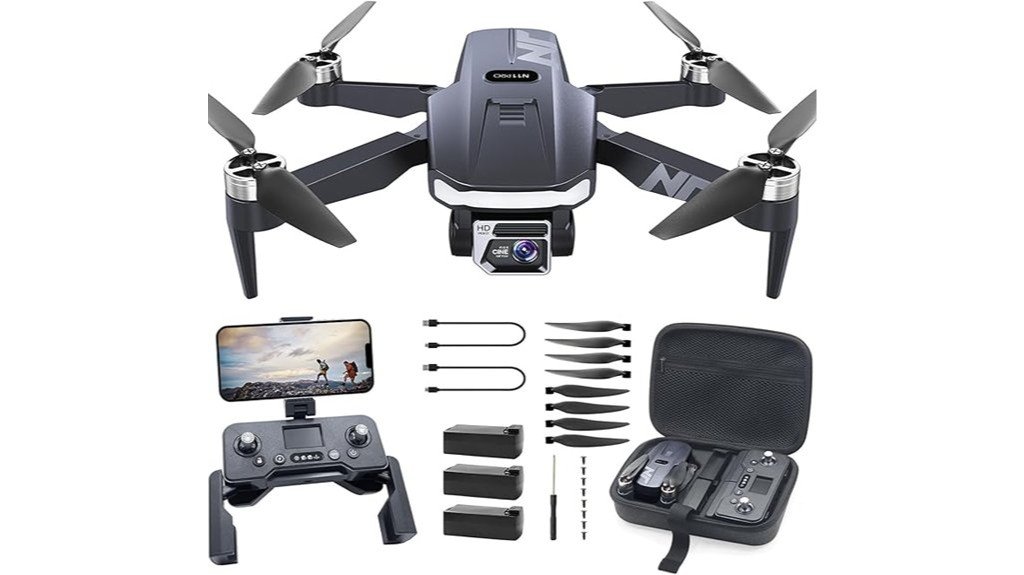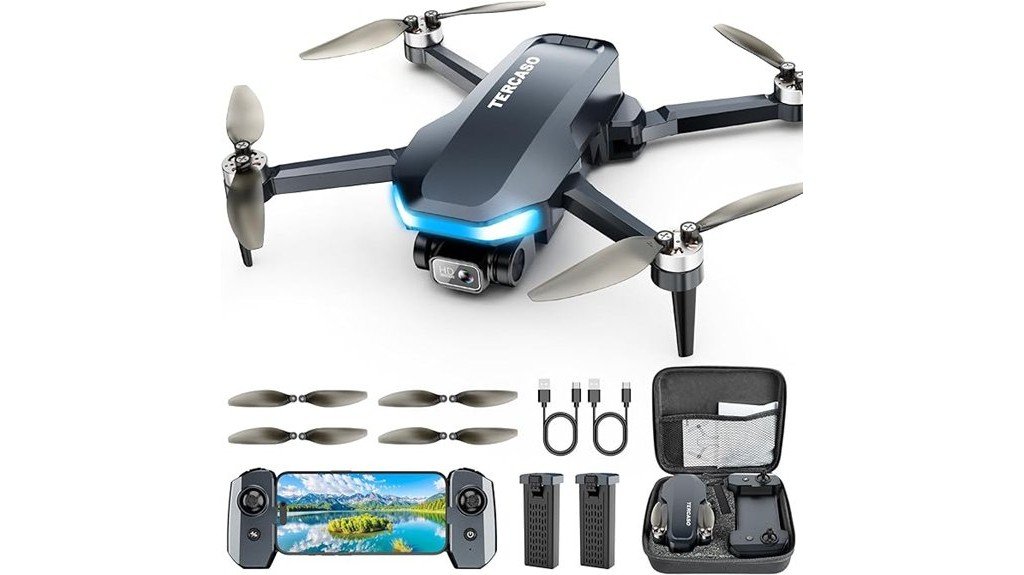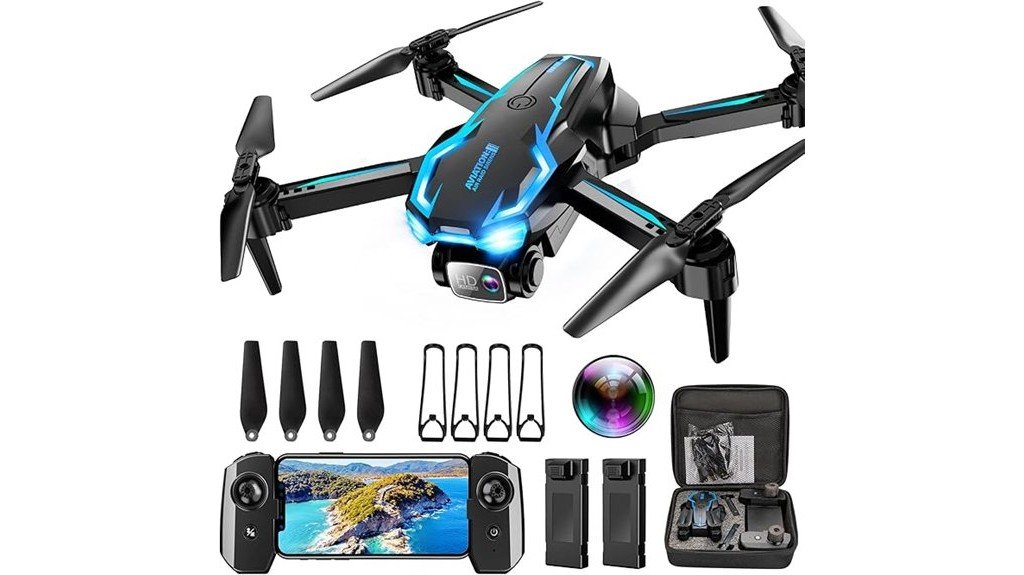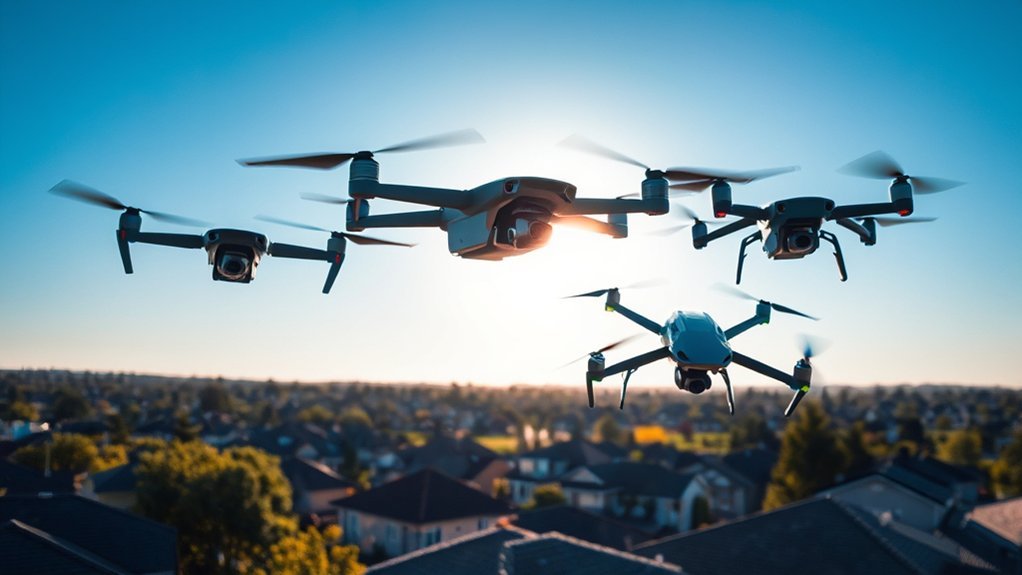For roof inspections in 2025, expert-recommended drones include the N11 Pro GPS Drone, offering a 4K UHD camera and a 90-minute flight time, perfect for detailed and efficient coverage. Consider the Drone with a 2K HD Camera featuring GPS and a weight under 250g for easy navigation and stability. Finally, the 2K HD FPV Drone provides real-time FPV transmission and foldability for convenience. Discover more about these versatile drones and make informed choices for your inspection needs.
N11 Pro GPS Drone with 4K UHD Camera and 90 Minutes Flight

If you’re in the market for a drone that’s perfect for roof inspections, the N11 Pro GPS Drone with its 4K UHD Camera and impressive 90-minute flight time is an excellent choice. You’ll appreciate its long-range control up to 3328 feet and the 5G FPV experience for real-time video transmission, ensuring you get detailed views from every angle. With features like auto return and intelligent tracking, your inspections are both efficient and safe. Its lightweight, foldable design means no FAA registration worries and easy portability. Plus, its stable hovering and simple setup make it ideal for beginners and hobbyists alike.
Best For: Individuals looking for a user-friendly drone suitable for roof inspections, with excellent visual quality and extended flight time.
Pros:
- 90 minutes extended flight time with 3 batteries
- 4K UHD camera with wide-angle lens for high-quality visuals
- Lightweight, foldable design for easy portability and no FAA registration
Cons:
- Limited range of 3328 feet might not suffice for some professional applications
- Video resolution lower than image resolution could affect video quality
- May not have advanced features needed by professional drone users
Drone with 2K HD Camera and GPS for Adults

When it comes to roof inspections, a drone with a 2K HD camera and GPS is an ideal choice for both professionals and hobbyists seeking precision and ease of use. This drone offers a 2K HD camera with FPV live video, ensuring clear images and videos. Its GPS and auto-return features enhance safety and convenience. Weighing under 250g, it’s portable and FAA-friendly, perfect for on-the-go inspections. Brushless motors and altitude hold provide stable flight, while features like Follow Me and Headless Mode cater to beginners. Plus, with two batteries, you’ll enjoy extended flight times for thorough inspections.
Best For: Professionals and hobbyists seeking a portable drone with high-quality camera capabilities and user-friendly controls for tasks such as roof inspections.
Pros:
- 2K HD camera with FPV live video for clear imagery
- GPS and auto-return features for enhanced safety
- Lightweight, portable design with extended flight time
Cons:
- Limited to 2K resolution, not 4K
- May not be suitable for advanced professional cinematography
- Requires additional purchase of an SD card for local storage
2K HD FPV Drone with Camera for Adults (Foldable & Portable)

The 2K HD FPV Drone with Camera for Adults is a fantastic choice for those seeking a versatile and portable solution for roof inspections. You’ll love its 2K Ultra HD camera with a 90° adjustable angle, capturing stunning aerial footage effortlessly. Its real-time FPV transmission lets you share visuals instantly via your smartphone. With helpful features like Altitude Hold, Optical Flow Positioning, and Headless Mode, even beginners can fly it with ease. Weighing under 250g, this foldable drone is travel-ready and doesn’t require FAA registration. Dual batteries provide 20 minutes of flight, ensuring you complete inspections without interruptions.
Best For: Adults and beginners seeking a portable and easy-to-use drone for capturing stunning aerial footage and performing tasks like roof inspections.
Pros:
- 2K Ultra HD camera with 90° adjustable angle for high-quality aerial shots.
- Lightweight and foldable design for easy portability, no FAA registration needed.
- User-friendly features like Altitude Hold and Headless Mode for effortless flying.
Cons:
- Limited 20-minute total flight time with dual batteries.
- Might not be suitable for professional or extended commercial use.
- May require a smartphone for optimal FPV transmission experience.
Factors to Consider When Choosing a Drone for Roof Inspections
When you’re choosing a drone for roof inspections, reflect on camera quality since it’s essential for detailed imagery. You’ll also want to take into account flight time and GPS features to guarantee efficiency and accuracy during inspections. Don’t forget about portability and user-friendly controls, which make handling the drone much easier.
Camera Quality Importance
Considering the essential role of camera quality in drone roof inspections, you should prioritize high-resolution cameras like 4K UHD to capture detailed imagery necessary for identifying subtle roof damage. A high-resolution camera is important because it exposes wear and damage not visible with lower resolutions. Additionally, adjustable camera angles, such as a 90° lens, allow you to capture diverse perspectives, enhancing the completeness of your inspection. Real-time FPV transmission offers immediate insights, facilitating swift decision-making during inspections. Built-in stabilization guarantees clear, stable video or image capture, minimizing blurriness that could hide issues. Finally, the ability to store high-quality images and videos on an SD card or smartphone supports extensive documentation and reporting, essential for accurate assessments and records.
Flight Time Duration
While camera quality plays a vital role in capturing detailed roof imagery, flight time duration is equally important for ensuring extensive inspections. Longer flights mean you can assess roofs thoroughly without constant recharging or swapping batteries. Look for drones offering up to 90 minutes of flight time with multiple batteries to efficiently cover larger areas. Keep in mind, a drone’s weight can affect flight time; lighter models often fly longer due to less battery strain. Additionally, advanced features like GPS stabilization might reduce flight time as they consume more power. Opt for drones with auto return features—these will safely bring the drone back when battery levels drop, essential for preventing loss during roof inspections.
GPS and Tracking
Equipped with GPS and tracking features, drones can transform roof inspections into a precise and efficient task. With GPS navigation, you’ll get precise location data, allowing for accurate mapping and inspection. Intelligent tracking guarantees the drone autonomously follows a designated path, giving you thorough coverage without constant manual control. The auto-return function is a lifesaver, bringing the drone back safely if the battery runs low or it loses signal, minimizing risks of damage or loss. Long-range control, often over 3000 feet, means you can inspect large roofs without constantly moving the drone. GPS and advanced tracking also provide stable hovering, essential for capturing high-quality images and videos, guaranteeing detailed inspections. These features make your inspection tasks more manageable and reliable.
Portability and Design
When you’re picking a drone for roof inspections, portability and design are key factors to keep in mind. Opt for a lightweight model under 0.55lb to bypass FAA registration hassles, making it easier to transport and use. A foldable design is a must, allowing the drone to fit snugly in backpacks or small bags, perfect for moving between sites. Don’t overlook durability; choose a sturdy build to handle various weather conditions during inspections. A carrying case is essential, offering convenience and protection, keeping your drone in top shape. With these features, your drone won’t just be easy to carry—it’ll also be ready to tackle any inspection challenge you throw at it, regardless of the terrain or weather.
User-Friendly Controls
After ensuring your drone is portable and well-designed, focus on its user-friendly controls to enhance your roof inspection experience. Opt for drones with one-key takeoff and landing, which simplify operations, especially if you’re a beginner. Look for features like altitude hold systems that keep the drone stable, allowing you to capture steady images without needing advanced piloting skills. Intuitive steering modes, such as headless mode, make maneuvering straightforward by aligning with your perspective rather than the drone’s orientation. Real-time FPV transmission lets you view live footage on your smartphone, simplifying navigation and inspection. Additionally, multiple speed settings enable you to adjust to your comfort level, ensuring a smooth experience regardless of the task’s complexity.
Stability and Hovering
While selecting a drone for roof inspections, focus on stability and hovering capabilities to guarantee clear and precise imaging. Drones equipped with GPS and Optical Flow technology offer steady hovering, making certain your images are sharp and detailed. Brushless motors enhance flight stability while reducing noise, perfect for capturing undisturbed visuals. An altitude hold feature maintains a consistent height, essential for evaluating roof conditions from different angles accurately. Advanced stabilization systems, like gyroscopic sensors, mitigate wind effects, providing reliable performance even in breezy conditions. Additionally, drones with longer flight times and multiple battery options allow you to inspect larger roof areas without needing frequent breaks. These features make certain thorough roof evaluations in a single, uninterrupted flight, maximizing efficiency.
Safety Features Necessity
Selecting a drone for roof inspections isn’t just about capturing great images; it’s important to prioritize safety features. You’ll want a drone with low-voltage alerts and overcurrent protection to prevent unexpected power loss. Propeller guards are essential, too, as they help avoid damage to both the drone and any nearby structures during close flights. A must-have is the emergency stop function, letting you halt operations instantly if something goes wrong. Stable hovering is crucial for inspections, so look for features like altitude hold and optical flow positioning. These guarantee your drone stays steady, capturing clear images without crashing. Finally, opt for a lightweight design, ideally under 250g, to reduce risks of injury or damage if it falls.
Real-Time Video Transmission
How can you guarantee that your drone provides the best real-time video transmission for roof inspections? Start by ensuring it has a 4K UHD camera, which offers crystal-clear footage essential for identifying roof issues. Opt for drones with 5GHz FPV technology to minimize lag and interference, ensuring smooth and accurate video feeds. A wide-angle lens, adjustable up to 90°, lets you cover more of the roof in a single frame, enhancing the inspection process. Also, look for features like Optical Flow positioning that stabilize video transmission, even in windy conditions, maintaining a steady, clear image. These elements combined will allow you to assess roof conditions effectively without the need for physical climbing, making inspections safer and more efficient.
Frequently Asked Questions
How Do Weather Conditions Affect Drone Performance During Roof Inspections?
Weather conditions drastically impact drone performance. High winds can destabilize flight, while rain can damage sensitive equipment. Make sure you check forecasts and avoid harsh conditions for best inspections, maintaining the drone’s longevity and guaranteeing safety for your operations.
Are There Specific Drones Recommended for Inspecting Solar Panel Roofs?
You might consider using drones like the DJI Mavic 3 Thermal or the Parrot Anafi USA. They perform like Hermes, swiftly capturing thermal and visual data, making them excellent choices for inspecting solar panel roofs efficiently.
What Are the Legal Requirements for Using Drones in Roof Inspections?
You need to follow FAA regulations, including registering your drone and obtaining a Remote Pilot Certificate. Always keep the drone within line of sight, avoid flying over people, and respect altitude limits to guarantee compliance.
How Do Drones Compare to Traditional Inspection Methods in Terms of Cost-Efficiency?
You’ll find drones are more cost-efficient than traditional methods. They reduce labor costs, speed up inspections, and minimize risks. By using drones, you can efficiently gather data without the need for extensive scaffolding or equipment.
What Safety Precautions Should Be Taken When Operating Drones for Roof Inspections?
Are you guaranteeing safety during drone operations? Always check weather conditions, maintain line of sight, and verify your equipment’s functioning properly. Keep a safe distance from people and obstacles, and don’t forget to follow FAA regulations.

